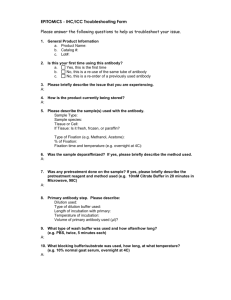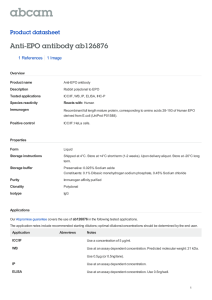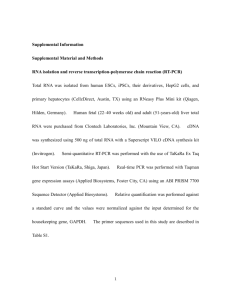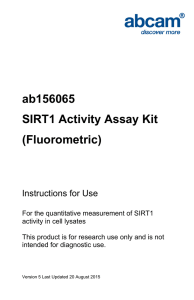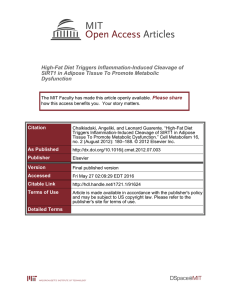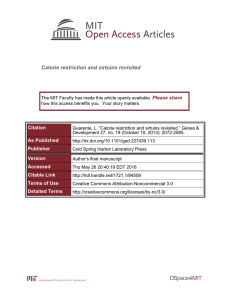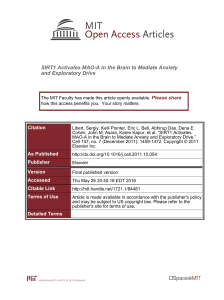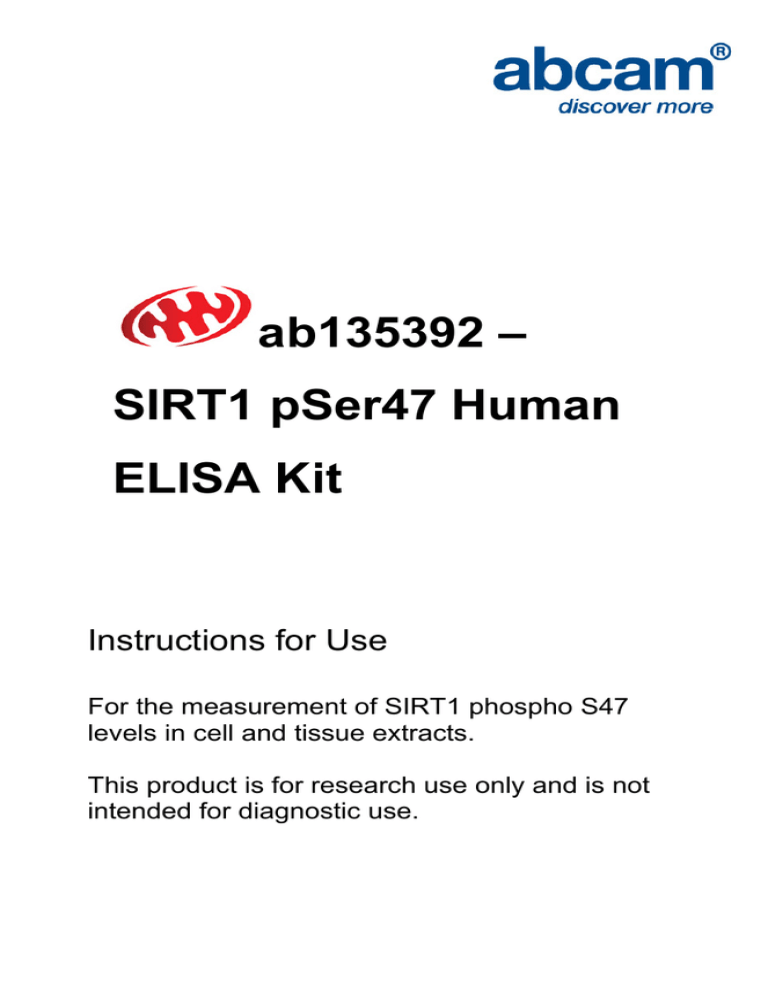
ab135392 –
SIRT1 pSer47 Human
ELISA Kit
Instructions for Use
For the measurement of SIRT1 phospho S47
levels in cell and tissue extracts.
This product is for research use only and is not
intended for diagnostic use.
Table of Contents
1.
Introduction
2
2.
Assay Summary
5
3.
Kit Contents
6
4.
Storage and Handling
6
5.
Additional Materials Required
7
6.
Preparation of Reagents
8
7.
Sample Preparation
9
8
Assay Procedure
13
9.
Data Analysis
15
10. Specificity
18
11. Troubleshooting
21
1
1. Introduction
Principle: ab135392 SIRT1 phospho S47 ELISA (Enzyme-Linked
Immunosorbent
Assay)
kit
is
an
in-vitro
enzyme-linked
immunosorbent assay for the accurate measurement of Human
SIRT phospho S47 in cell and tissue lysates. The assay employs a
SIRT1 specific antibody coated onto well plate strips. Samples are
pipetted into the wells and SIRT1 protein present in the sample is
bound to the wells by the immobilized antibody.
The wells are
washed and a primary anti-phospho S47 detector antibody is added.
After washing away unbound detector antibody, HRP-conjugated
secondary detector antibody (HRP Label) specific for the primary
detector antibody is pipetted to the wells.
The wells are again
washed, a TMB substrate solution is added to the wells and color
develops in proportion to the amount of phosphorylated SIRT1 at
serine 47 bound. The developing blue color is measured at 600 nm.
Optionally the reaction can be stopped by adding hydrochloric acid
which changes the color from blue to yellow and the intensity can be
measured at 450 nm.
2
Background: This SIRT1 phospho S47 ELISA Kit is an enzyme
immunoassay developed for the sensitive detection phosphorylated
SIRT1 at residue S47. The kit has a detection sensitivity limit in
ek293T cells of 2 µg/mL of lysate.
Each kit provides sufficient
reagents to perform up to 96 assays including standard curve with a
reference sample and test samples.
SIRT1 - silent mating type information regulation 2 homolog (homolog of yeast Sir2) is a member of the sirtuins family of
deacetylases.
Sirtuin1 deactylates a growing number of proteins
such as Histone H3, PGC1a, FOXO1, FOXO3, p53, Notch, NF-kB,
HIF1a, LXR, FXR, SREBP1c and therefore affects a wide array of
processes such as
epigenetic silencing, apoptosis, senescence,
adipogenesis, fatty acid oxidation, insulin secretion, glycolysis,
gluconeogenesis and muscle differentiation.
Furthermore SIRT1
may serve as a cytosolic NAD+/NADH sensor and may also regulate
the circadian clock of the cell in response to metabolic conditions.
The activity of SIRT1 is regulated by gene expression, posttranslational
modification
(phosphorylation
and
sumoylation),
complex formation, substrate availability (NAD+/NADH, NAD+
precursors such as nicotinamide) and plant polyphenols such as
resveratrol. Activation of SIRT1 by phosphorylation is carried out by
the cyclin B-CDK1 complex, the JUN N-terminal kinase (JNK) and by
DYRK1 and DYRK3.
Cyclin B-CDK1 phosphorylates SIRT1 at
residues thr530 and s540 which in turn affects progression through
3
the cell cycle. JNK phosphorylates SIRT1 at residues s27, s47 and
thr530 resulting in deacetylation of histone H3 but not of p53. On the
other hand DYRK1 and DYRK3 phosphorylate SIRT1 at residue
Thr522 leading to deacetylation of p53 and prevention of apoptosis
within the context of genotoxic stress.
Pharmacological activation of sirtuins is thought to be beneficial not
only for diseases relating to metabolism, such as type 2 Diabetes
and obesity, but also for neurodegenerative diseases such as
Alzheimer’s disease and Parkinson’s disease.
4
2. Assay Summary
Equilibrate all reagents to room temperature. Prepare all the
reagents, samples, and standards as instructed.
Add 50 µL sample to each well used. Incubate 2 hours at room
temperature.
Aspirate and wash each well three times. Add 50 μL prepared
primary detector antibody to each well. Incubate 1 hour at room
temperature.
Aspirate and wash each well three times. Add 50 μL prepared
HRP labeled secondary detector antibody. Incubate 1 hour at
room temperature.
Aspirate and wash each well three times. Add 100 μL TMB
Development Solution to each well. Immediately begin
recording the color development with elapsed time at 600 nm for
15 minutes. Alternatively add a stop solution at a user-defined
time and read at 450 nm.
5
3. Kit Contents
Item
Quantity
20X Buffer
20 mL
Extraction Buffer
15 mL
10X Blocking Buffer
6 mL
TMB Development Solution
12 mL
10X SIRT1 pSer47 Detector Antibody
1 mL
10X HRP Label
1 mL
SIRT1 Microplate (12 x 8 antibody coated well strips)
96 Wells
4. Storage and Handling
Store all components at 4°C.
This kit is stable for 6 months after
receipt. Unused microplate strips should be returned to the pouch
containing the desiccant and resealed.
6
5. Additional Materials Required
Microplate reader capable of measuring absorbance at
600 nm (or 450 nm after addition of stop solution - not
supplied.
Method for determining protein concentration (BCA assay
recommended).
Deionized water
Multi- and single-channel pipettes
PBS (1.4 mM KH2PO4, 8 mM Na2HPO4, 140 mM NaCl,
2.7 mM KCl, pH 7.3).
Tubes for standard dilution
Stop solution (optional) – 1N hydrochloric acid
Optional plate shaker for all incubation steps
7
6. Preparation of Reagents
6.1
Equilibrate all reagents to room temperature (18-25°C)
prior to use.
6.2
Prepare 1X Wash Buffer by adding 20 mL 20X Buffer to
380 mL nanopure water.
6.3
Prepare 1X Incubation Buffer by adding 6 mL 10X
Blocking Buffer to 54 mL 1X Wash Buffer. Excess unused
1X Incubation Buffer may be stored at -20°C for 6 months
after performing the ELISA.
6.4
Prepare the 1X Primary Detector Antibody by diluting 10X
SIRT1
pSer47
Detector
Antibody
10-fold
with
1X
Incubation Buffer immediately prior to use. Prepare 500
µL for each 8 well strip used.
6.5
Prepare the 1X HRP labeled secondary antibody by
diluting 10X HRP Label 10-fold with 1X Incubation Buffer
immediately prior to use. Prepare 500 µL for each 8 well
strip used.
8
7. Sample Preparation
Note: The extraction buffer should be supplemented with either
10mM Sodium Fluoride or a phosphatase inhibitor cocktail. It
may also be supplemented with PMSF and/or protease inhibitor
cocktail prior to use. Supplements should be used according to
manufacturer’s instructions.
7.1 Cell lysates
7.1.1
Collect non-adherent cells by centrifugation or
scrape to collect adherent cells from the culture
flask. Typical centrifugation conditions for cells are
500 x g for 10 min at 4°C.
7.1.2
Rinse cells twice with PBS.
7.1.3
Solubilize cell pellet at 2x107/mL in 500 µL of
Extraction Buffer.
Adjust volume with lower cell
counts.
7.1.4
Incubate on ice for 20 minutes. Centrifuge at 16,000
x g for 20 minutes at 4°C. Transfer the supernatants
into clean tubes and discard the pellets.
Assay
samples immediately or aliquot and store at -80°C.
The sample protein concentration in the extract may
be quantified using a protein assay.
9
7.2 Tissue lysates
7.2.1
Tissue
lysates
are
typically
prepared
by
homogenization of tissue that is first minced and
thoroughly rinsed in PBS to remove blood (dounce
homogenizer recommended).
7.2.2
Suspend the homogenate to 25 mg/mL in PBS.
7.2.3
Solubilize the homogenate by adding 4 volumes of
Extraction Buffer to a sample protein concentration
of 5 mg/mL.
7.2.4
Incubate on ice for 20 minutes. Centrifuge at 16,000
x g for 20 minutes at 4°C. Transfer the supernatants
into clean tubes and discard the pellets.
Assay
samples immediately or aliquot and store at -80°C.
The sample protein concentration in the extract may
be quantified using a protein assay.
The sample should be diluted to within the working
range of the assay in 1X Incubation Buffer. As a
guide, typical ranges of sample concentration for
commonly used sample types are shown below in
the Data Analysis section.
10
7.3 Preparation of dilution series of a positive control
sample
Note: It is strongly recommended to prepare a dilution series
of a positive control sample. The levels of phosphorylated
Ser47 of SIRT1 are elevated in certain cell lines such as
Hek293T and Jurkat cells and may be relatively low in other
cells and tissues. Use the positive control sample to prepare
the dilution series. The relative levels of phosphorylated
Ser47 of SIRT1 in other experimental samples can be
interpolated from within this positive control sample series.
7.3.1
To prepare serially diluted positive control sample,
first label six tubes #2-7.
7.3.2
Prepare a positive control sample lysate or extract
as directed in previous section (7.1 or 7.2). Dilute
the
positive
control
sample
to
an
upper
concentration limit of the working range of the assay
in the 1X Incubation Buffer used to dilute other
experimental samples. Label this tube #1.
7.3.3
Add 150 µL of the 1X Incubation Buffer to each of
tubes #2 through #7.
11
7.3.4
Transfer 150 µL from tube #1 to tube #2 and mix
thoroughly. With a fresh pipette tip transfer 150 µL
from #2 to #3 and mix thoroughly. Repeat for Tubes
#4 through #7. Use the diluent as the zero standard
tube labeled #8. Use fresh control sample dilution
series for each assay.
150 l
1
Positive control
sample
150 l
150 l
150 l
150 l
2
3
4
5
1/2
1/4
1/8
1/16
150 l
6
1/32
7
1/64
12
8 Assay Procedure
Equilibrate all reagents to room temperature before use. It is
recommended all samples and standards be assayed in
duplicate.
8.1
Prepare all reagents, working standards, and samples as
directed in the previous sections.
8.2
Remove unused microplate strips from the plate frame,
return them to the foil pouch containing the desiccant
pack, and reseal.
8.3
Load diluted samples at 50 µL per well.
8.4
Cover/seal the plate and incubate for 2 hours at room
temperature.
If available use a plate shaker for all
incubation steps at 300 rpm.
8.5
Aspirate each well and wash, then repeat this twice more
for a total of three washes.
Wash by aspirating or
decanting from wells then dispensing 300 µL 1X Wash
Buffer into each well as described above.
Complete
removal of liquid at each step is essential to good
performance. After the last wash, remove the remaining
buffer by aspiration or decanting. Invert the plate and blot
it against clean paper towels to remove excess liquid.
8.6
Immediately prior to use prepare sufficient (500 µL/8 well
strip used) 1X Primary Detector Antibody (step 6.4). Add
50 µL 1X Primary Detector Antibody to each well used.
Cover/seal the plate and incubate for 1 hour at room
13
temperature.
If available use a plate shaker for all
incubation steps at 300 rpm.
8.7
Repeat the aspirate/wash procedure above.
8.8
Immediately before use, prepare sufficient (500 µL/8 well
strip used) 1X HRP labeled secondary detector antibody
(step 6.5). Add 50 µL 1X HRP labeled secondary detector
antibody to each well used.
Cover/seal the plate and
incubate for 1 hour at room temperature. If available use a
plate shaker for all incubation steps at 300 rpm.
8.9
Repeat the aspirate/wash procedure above.
8.10 Add 100 µL of TMB Development Solution to each empty
well and immediately record the blue color development
with elapsed time in the microplate reader prepared with
the following settings:
Mode:
Kinetic
Wavelength:
600 nm
Time:
up to 15 min.
Interval:
20 sec. - 1 min.
Shaking:
Shake between readings
Alternative– In place of a kinetic reading, at a user defined,
time record the endpoint OD data at (i) 600 nm or (ii) stop
the reaction by adding 100 µL stop solution (1N HCl) to each
well and record the OD at 450 nm. Analyze the data as
described below.
14
9. Data Analysis
Subtract average zero standard reading from all readings. Average
the duplicate readings of the positive control dilutions and plot
against their concentrations. Draw the best smooth curve through
these points to construct a standard curve.
Most plate reader
software or graphing software can plot these values and curve fit. A
four parameter algorithm (4PL) usually provides the best fit, though
other equations can be examined to determine which provides the
most accurate results (e.g. linear, semi-log, log/log, 4 parameter
logistic).
Read relative SIRT1 phospho Ser47 concentrations for
unknown samples from the standard curve plotted.
Samples
producing signals greater than that of the highest standard should be
further diluted and reanalyzed, then multiply the concentration found
by the appropriate dilution factor.
15
Change mOD/min (600 nm)
TYPICAL STANDARD CURVE - For demonstration only.
100
10
1
10
100
1000
Hek293T Extract (g/mL)
Figure 1. Example of positive control sample standard curve. A
dilution series of extract diluted in 1X Incubation Buffer in the
working range of the assay. The extract was prepared with Hek293T
cells grown in High Glucose DMEM supplemented with 10% FCS.
TYPICAL SAMPLE RANGE
Typical working ranges
Sample Type
Hek293T
Jurkat
Range
2 – 1000 µg/mL
7 – 1000 µg/mL
SENSITIVITY
Calculated minimum detectable dose = 2 µg/mL (zero dose n=25 + 2
standard deviations) using Hek293T cells
16
LINEARITY OF DILUTION
Linearity of dilution was determined by comparing dilution series of
extracts prepared from Hek293T cells (starting protein concentration
is 500 µg/mL) to extracts prepared from Jurkat cells.
Jurkat (µg/mL)
% Expected Value
250
125
100%
99.6%
62.5
99.7%
31.3
97.5%
15.6
94.4%
RECOVERY
Sample Type
Average Recovery (%)
Range (%)
50% Culture Media
74%
61 – 87%
10% Serum
75%
63 – 91%
50% Extraction Buffer
94%
88 – 106%
REPRODUCIBILITY
Parameter
CV%
Intra (n= 10)
5.4%
Inter (n=3 days)
4.4%
17
10. Specificity
The specificity of the assay to measure SIRT1 phosphorylated at
serine 47 was demonstrated with the use of λ protein phosphatase (λ
Ppase) treatment of Hek293T extracts. The relative levels of the
phosphorylated S47 in extracts decreased dramatically when treated
with 1:100 dilution of the enzyme (Fig. 2). This result matched well
with a parallel Western blot analysis (using the kit’s detector
antibody) of the same protein phosphatase treated sample used on
the ELISA format.
The total levels of SIRT1 protein were not
sensitive to protein phosphatase treatment as determined by
Western blotting (Fig. 3).
Hek293T cells were lysed with the kit’s extraction buffer without
phosphatase inhibitor supplements and lysate was divided into three
vials: Control, Mock and λ Ppase.
The control vial was
supplemented with 10 mM sodium fluoride and a cocktail containing
sodium orthovanadate, sodium molybdate, sodium tartrate and
imidazole (not provided with the kit) and left on ice. The Mock and λ
Ppase aliquots were diluted 1:4 in 50 mM Hepes, 100 mM NaCl , 2
mM DTT , 0.01 % Brij 35 (pH 7.5) and 1mM MnCl2 (not provided
with the kit). λ Ppase was added at 1:100 dilution to the respective
vial and both mock and treated vials were incubated at 34˚C for 45
minutes. At the end of the treatment, all samples were divided into
two further vials, one was diluted in SDS loading buffer and analyzed
18
by Western blotting whereas the other was diluted in 1X Incubation
Buffer and analyzed with the kit.
Figure 2. The SIRT1 phospho S47 ELISA specifically measures the
phosphorylated serine.
Hek293T extracts were left untreated
(control), treated with heat only at 34˚C (Mock) or treated with 1:100
dilution of λ Ppase at 34˚C. Samples were loaded at 750 µg/mL on
the plate and measured following the kit’s protocol. Treatment of
Hek293T extracts with λ Ppase decreases the signal to background
levels.
19
1
2
3
A
Sirt1 phospho S47
B
Total Sirt1
Figure 3. The detector antibody used in this kit specifically detects
the phosphorylated SIRT1 as determined by western blotting.
Hek293T extracts were left untreated (lane 1), treated with heat only
(lane 2) or treated with 1:100 dilution of λ Ppase at 34˚C (lane 3).
Samples were then diluted in SDS-PAGE buffer and loaded at 30
µg/well. Membranes were blocked with the kit’s blocking reagent at
1X concentration and incubated with either the detector antibody
against SIRT1 phospho S47 (A) or the capture antibody against total
SIRT1 (B) and label with secondary antibodies conjugated to HRP.
λ Ppase completely dephosphorylates SIRT1 without affecting the
protein levels.
20
11. Troubleshooting
Problem
Cause
Solution
Inaccurate pipetting
Check pipette
Poor
standard
curve
Prior to opening, briefly spin the
Improper standard
stock standard tube and dissolve
dilution
the powder thoroughly by gentle
mixing
Incubation times too
brief
Low Signal
Inadequate reagent
volumes or improper
dilution
Plate is insufficiently
Large CV
washed
Contaminated wash
buffer
Ensure sufficient incubation times;
change to overnight
standard/sample incubation
Check pipettes and ensure correct
preparation
Review manual for proper wash
technique. If using a plate washer,
check all ports for obstructions
Make fresh wash buffer
Store the reconstituted protein at -
Low
Improper storage of
80°C, all other assay components
sensitivity
the ELISA kit
4°C. Keep substrate solution
protected from light.
21
22
UK, EU and ROW
Email: technical@abcam.com
Tel: +44 (0)1223 696000
www.abcam.com
US, Canada and Latin America
Email: us.technical@abcam.com
Tel: 888-77-ABCAM (22226)
www.abcam.com
China and Asia Pacific
Email: hk.technical@abcam.com
Tel: 108008523689 (中國聯通)
www.abcam.cn
Japan
Email: technical@abcam.co.jp
Tel: +81-(0)3-6231-0940
www.abcam.co.jp
Copyright © 2012 Abcam, All Rights Reserved. The Abcam logo is a registered trademark.
All information / detail is correct at time of going to print.
23


